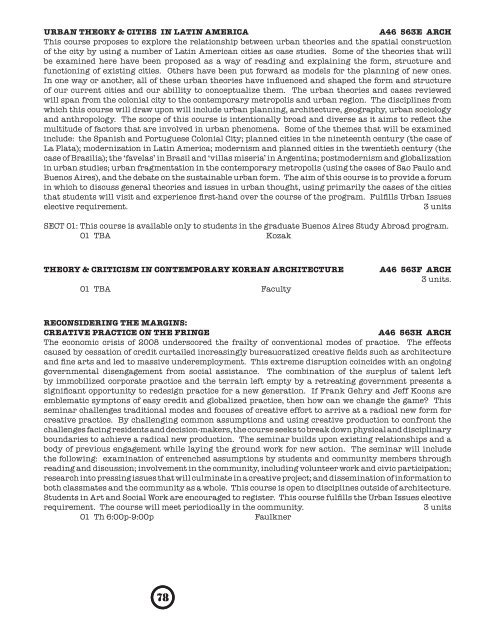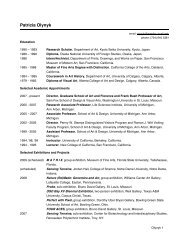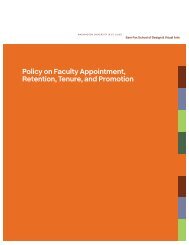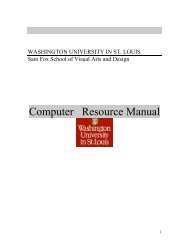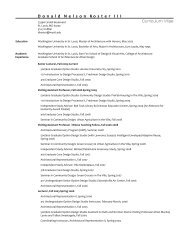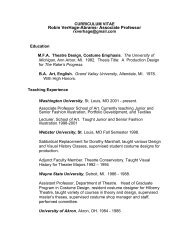architecture - Sam Fox School - Washington University in St. Louis
architecture - Sam Fox School - Washington University in St. Louis
architecture - Sam Fox School - Washington University in St. Louis
You also want an ePaper? Increase the reach of your titles
YUMPU automatically turns print PDFs into web optimized ePapers that Google loves.
URBAN THEORY & CITIES IN LATIN AMERICA A46 563E ARCH<br />
This course proposes to explore the relationship between urban theories and the spatial construction<br />
of the city by us<strong>in</strong>g a number of Lat<strong>in</strong> American cities as case studies. Some of the theories that will<br />
be exam<strong>in</strong>ed here have been proposed as a way of read<strong>in</strong>g and expla<strong>in</strong><strong>in</strong>g the form, structure and<br />
function<strong>in</strong>g of exist<strong>in</strong>g cities. Others have been put forward as models for the plann<strong>in</strong>g of new ones.<br />
In one way or another, all of these urban theories have <strong>in</strong>fluenced and shaped the form and structure<br />
of our current cities and our abillity to conceptualize them. The urban theories and cases reviewed<br />
will span from the colonial city to the contemporary metropolis and urban region. The discipl<strong>in</strong>es from<br />
which this course will draw upon will <strong>in</strong>clude urban plann<strong>in</strong>g, <strong>architecture</strong>, geography, urban sociology<br />
and anthropology. The scope of this course is <strong>in</strong>tentionally broad and diverse as it aims to reflect the<br />
multitude of factors that are <strong>in</strong>volved <strong>in</strong> urban phenomena. Some of the themes that will be exam<strong>in</strong>ed<br />
<strong>in</strong>clude: the Spanish and Portuguese Colonial City; planned cities <strong>in</strong> the n<strong>in</strong>eteenth century (the case of<br />
La Plata); modernization <strong>in</strong> Lat<strong>in</strong> America; modernism and planned cities <strong>in</strong> the twentieth century (the<br />
case of Brasilia); the ‘favelas’ <strong>in</strong> Brasil and ‘villas miseria’ <strong>in</strong> Argent<strong>in</strong>a; postmodernism and globalization<br />
<strong>in</strong> urban studies; urban fragmentation <strong>in</strong> the contemporary metropolis (us<strong>in</strong>g the cases of Sao Paulo and<br />
Buenos Aires), and the debate on the susta<strong>in</strong>able urban form. The aim of this course is to provide a forum<br />
<strong>in</strong> which to discuss general theories and issues <strong>in</strong> urban thought, us<strong>in</strong>g primarily the cases of the cities<br />
that students will visit and experience first-hand over the course of the program. Fulfills Urban Issues<br />
elective requirement. 3 units<br />
SECT 01: This course is available only to students <strong>in</strong> the graduate Buenos Aires <strong>St</strong>udy Abroad program.<br />
01 TBA Kozak<br />
THEORY & CRITICISM IN CONTEMPORARY KOREAN ARCHITECTURE A46 563F ARCH<br />
3 units.<br />
01 TBA Faculty<br />
RECONSIDERING THE MARGINS:<br />
CREATIVE PRACTICE ON THE FRINGE A46 563H ARCH<br />
The economic crisis of 2008 underscored the frailty of conventional modes of practice. The effects<br />
caused by cessation of credit curtailed <strong>in</strong>creas<strong>in</strong>gly bureaucratized creative fields such as <strong>architecture</strong><br />
and f<strong>in</strong>e arts and led to massive underemployment. This extreme disruption co<strong>in</strong>cides with an ongo<strong>in</strong>g<br />
governmental disengagement from social assistance. The comb<strong>in</strong>ation of the surplus of talent left<br />
by immobilized corporate practice and the terra<strong>in</strong> left empty by a retreat<strong>in</strong>g government presents a<br />
significant opportunity to redesign practice for a new generation. If Frank Gehry and Jeff Koons are<br />
emblematic symptons of easy credit and globalized practice, then how can we change the game? This<br />
sem<strong>in</strong>ar challenges traditional modes and focuses of creative effort to arrive at a radical new form for<br />
creative practice. By challeng<strong>in</strong>g common assumptions and us<strong>in</strong>g creative production to confront the<br />
challenges fac<strong>in</strong>g residents and decision-makers, the course seeks to break down physical and discipl<strong>in</strong>ary<br />
boundaries to achieve a radical new production. The sem<strong>in</strong>ar builds upon exist<strong>in</strong>g relationships and a<br />
body of previous engagement while lay<strong>in</strong>g the ground work for new action. The sem<strong>in</strong>ar will <strong>in</strong>clude<br />
the follow<strong>in</strong>g: exam<strong>in</strong>ation of entrenched assumptions by students and community members through<br />
read<strong>in</strong>g and discussion; <strong>in</strong>volvement <strong>in</strong> the community, <strong>in</strong>clud<strong>in</strong>g volunteer work and civic participation;<br />
research <strong>in</strong>to press<strong>in</strong>g issues that will culm<strong>in</strong>ate <strong>in</strong> a creative project; and dissem<strong>in</strong>ation of <strong>in</strong>formation to<br />
both classmates and the community as a whole. This course is open to discipl<strong>in</strong>es outside of <strong>architecture</strong>.<br />
<strong>St</strong>udents <strong>in</strong> Art and Social Work are encouraged to register. This course fulfills the Urban Issues elective<br />
requirement. The course will meet periodically <strong>in</strong> the community. 3 units<br />
01 Th 6:00p-9:00p Faulkner<br />
78


